Remove the fuel pump installation screws, then remove the fuel pump assembly from the fuel tank
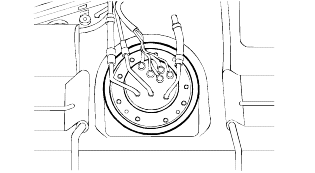
Reduce the fuel pressure before disconnecting the fuel line and hose, or fuel will spill out.
Cover the pipe connection with a shop towel to prevent splashing of fuel from residual pressure in the fuel line.
Remove the fuel pump installation screws, then remove the fuel pump assembly from the fuel tank

Remove the fuel return hose and line.
Remove the fuel vapor hose and line
Install the fuel vapor hose and return hoses.
If the fuel line has a stepped section, connect the fuel hose to the line securely, as shown in the illustration.
If the fuel line does not have a stepped section, connect the fuel hose to the line securely.
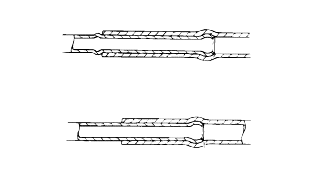
Install the fuel filter and tighten the fuel filter bracket.
Tighten the two fitting nuts while holding the fuel filter nuts.
Tightening torque Fuel filter fitting nuts : |
20~40 Nm (300~400 kg·cm, 22.1~29.5 lb·ft) |
Install the clips and make sure that they do not interfere with other components.
Check the hoses and pipes for cracking, bending, deformation or restrictions.
Check the EVAP Canister for restrictions.
Check the fuel pump assembly for restrictions and damage.
Reduce the internal pressure of the fuel lines and hoses:
Disconnect the fuel pump harness connector
Start the engine and after it stalls, turn the ignition switch to the OFF position
Disconnect the battery negative (-) terminal
Connect the fuel pump harness connector
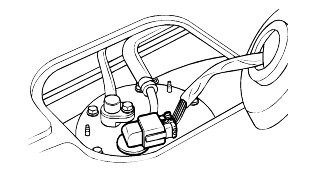
Remove the bolt connecting the fuel line to the fuel delivery pipe.

Cover the hose connection with a shop towel to prevent splashing of fuel caused by residual pressure in the fuel line.
Using the fuel pressure gauge adapter, install the fuel pressure gauge to the fuel pressure gauge adaptor. Tighten the bolt to the specifiedtorque.
Fuel pressure gauge to fuel delivery pipe : |
25~35 Nm (250~350 kg·cm, 18~26 lb·ft) |
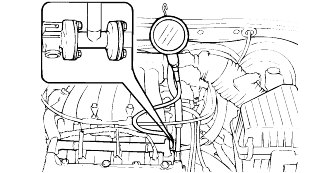
Connect the battery's negative (-) terminal.
Apply battery voltage to the terminal for the pump drive and activate the fuel pump. With fuel pressure applied, check that there is no fuel leakagefrom the pressure gauge or connection part.
Start and run the engine at curb idle speed.
Disconnect the vacuum hose from the pressure regulator, and plug the hose end. Measure the fuel pressure at idle.
Standard value : |
320~340 kPa (3.26~3.47 kg/cm², 46~49 psi) |
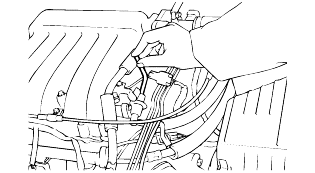
Standard value : |
Approx.255 kPa (2.57 kg/cm², 37 psi) |
If the results of the measurements made in steps (7) and (8) are not within the standard value, use the table below to determine the probablecause, and make the necessary repairs.
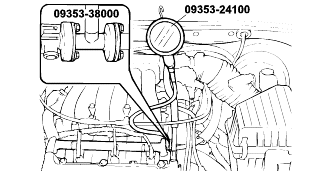
Condition | Probable cause | Remedy |
Fuel pressure is too low | ● Clogged fuel filter ● Fuel leakage to the return side, caused by poor seating of the fuel-pressure regulator | ● Replace fuel filter ● Replace fuel pressure regulator |
● Low discharge pressure of the fuel pump | ● Check the in-tank fuel hose for large or replace the fuel pump | |
Fuel pressure is too high | ● Sticking fuel pressure regulator ● Clogged or bent fuel return hose or pipe | ● Replace fuel pressure regulator ● Repair or replace hose or pipe |
There is no difference in fuel pressure when the vacuum hose is connected and when it is not. | ● Clogged, or damaged vacuum hose or nipple ● Sticking or poor seating of the fuel pressure regulator | ● Repair or replace the vacuum hose or the nipple ● Repair or replace hose or pipe |
Stop the engine and check for a change in the fuel pressure gauge reading, which should hold for approximately 5 minutes. If the gauge indication drops, observe the rate at which it drops. Determine and remove the causesaccording to the following table.
Condition | Probable cause | Remedy |
Fuel pressure drops slowly after engine is stopped | ● Injector leakage | ● Replace injector |
Fuel pressure drops immediately after engine is stopped | ● The check valve within the fuel pump is open | ● Replace fuel pump |
Reduce the pressure in the fuel line.
Disconnect the hose and the gauge.
Cover the hose connection with a shop towel to prevent splashing of fuel caused by fuel residual pressure in the fuelline.
Replace the O-ring at the end of the hose.
Connect the fuel hose to the delivery pipe and tighten to the specified torque.
Check for fuel leakage.
Apply battery voltage to the fuel pump drive terminal to operate the fuel pump.
With pressure, check the fuel line for leaks.
